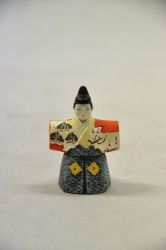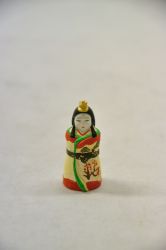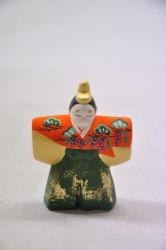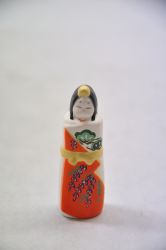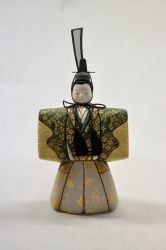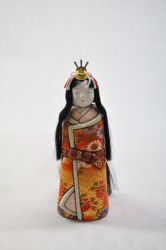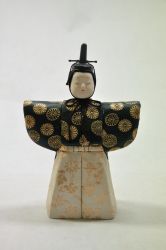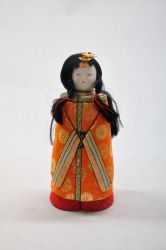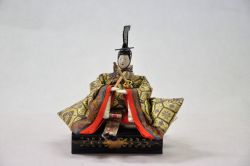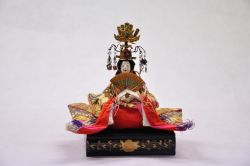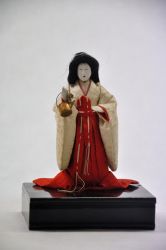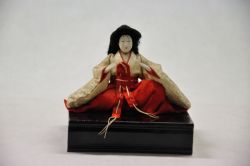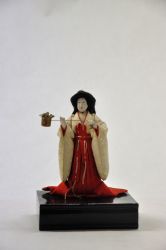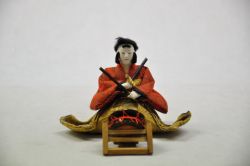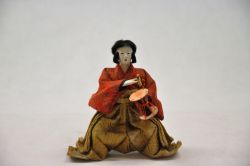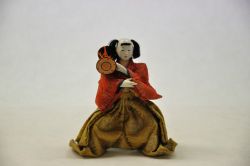Hina Ningyo
Hina Ningyo 雛 人形 are traditional Japanese dolls, which represent a couple of high rank. Depending on the set, court ladies, musicians, ministers and other staff can be added. Moreover, pieces of furniture and dishes are often included in the decoration. The correct order of the installation and the number of dolls may vary and are not clearly defined. Every year on the third of March, these dolls are exhibited during hinamatsuri 雛 祭 り.
The tradition of hinamatsuri goes back to the Heian period (794-1192). It has its origins in a cleaning ritual. With the aid of nademono, impurities are removed from human subjects. Bona fide festivals developped from these rituals. In the wake of these festivals, different types of dolls such as the Amagatsu 天 児 (dolls that were made specifically for newborns) or Hoko 這 子 originated. This form of hinamatsuri can be seen even today such as in the Awashima Shrine, Wakayama. These dolls are collected throughout the year and then burned. On the third of March, the hina dolls are placed on boats to be washed away by the sea. The nagashibina 流 し 雛 dolls are used in a similar fashion. At the outset, the hina dolls only represented one couple. They served as vessels for kami 神 (Japanese deities) to allow them entering the house and, thereby, cleaning it from impurities. At that time, these dolls were made of paper. Beginning in 1629, an official celebration day for these dolls was officially listed in the calendar. These dolls were also the first to be put on public display. Towards the end of the Edo period, the hina dolls started to representt other characters, and the sets could contain up to fifteen invidual dolls. In the wake of commercialization, the hina matsuri turned into a girl`s festival.
Until today, many different types of hina dolls exist. The tachibina 立 ち 雛 (means "standing Hina") are among the most ancient types of hina dolls. Previously. they were made of paper, but they are also available in kimekomi- or hakata style today. The first seated hina dolls originated in Kan'ei era (1624-1644). They have influenced the characteristics of later hina dolls importantly . More and more, they replaced the tachibina.
The production process of hina ningyo can be divided into several steps: hands / feet, head, hair, clothing / body. The hands and feet are made with the aid of pieces of wood and wires. The wires are pushed into the wood and form the fingers or toes. First, a base layer of gofun is applied to the timber and the wires, then an additional layer is put on top. The individual fingers are precisely defined and detailled carvings like fingernails and wrinkles are shown. The head of the doll is made of wood and/or pressed, hardened sawdust, a technique similar to production of toso in the Kimekomi. The head is shaped using a model, and then dried. Then the eyes are inserted and covered by the first base layer and are painted. The face is finally processed in a way that leads to reappearace of the inlaid eyes. The eyes, lids and brows now appear very close to real eyes. Finally, the doll is painted on the lips, eyebrows and hairline. For the construction of the hair, deep grooves are carved at the hairline. The hair is glued slightly behind the groove and then pushed by means of adhesive in the groove, so it looks as if the hair is actually growing out of the head. Thereafter, the hair can be styled as desired and decorated. The rest of the body normally consists of straw which is wrapped with paper. The clothing is made up of paper and cloth, folded, ironed, sewn and glued together. To ensure the balance of the doll, the fabric is sometimes stuffed with cotton. At the very end, the head and hands are inserted into the doll. Modern hina ningyo can also have plastic or porcelain pieces.
